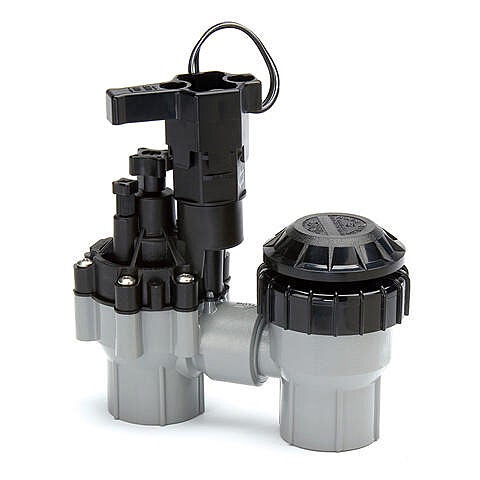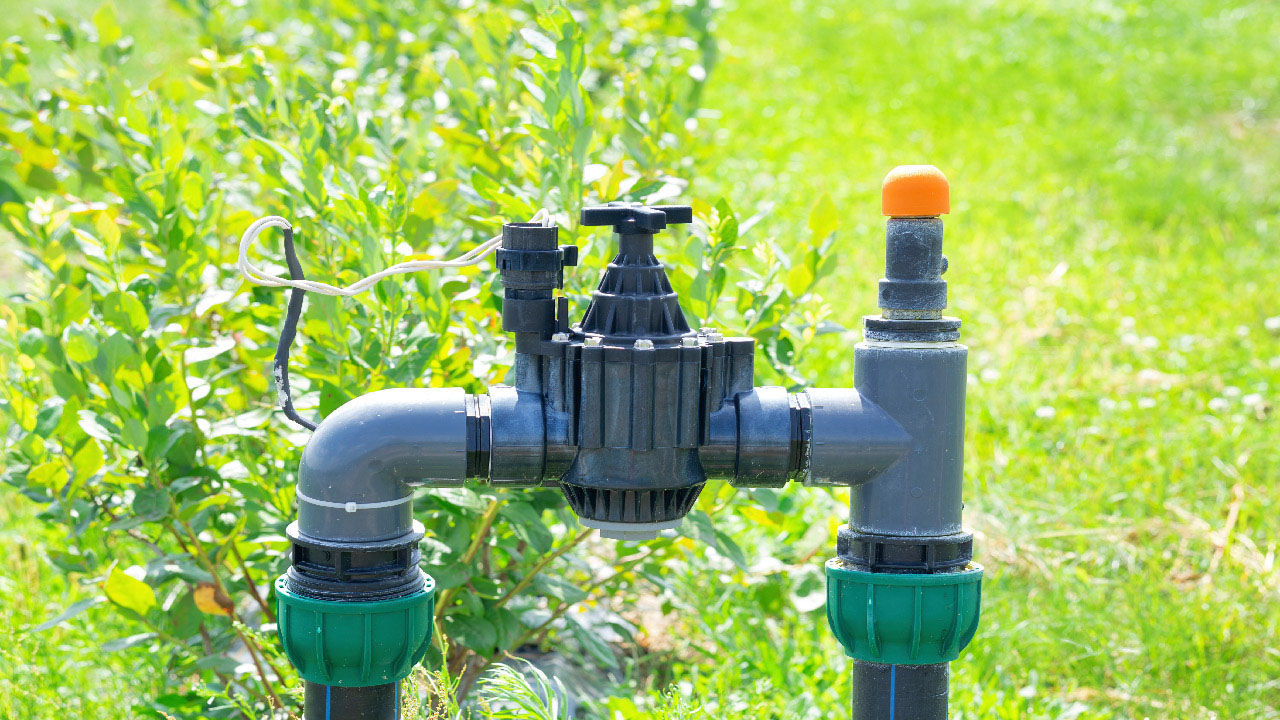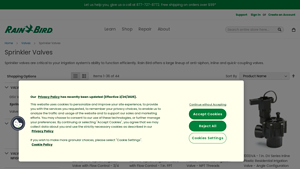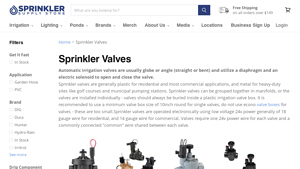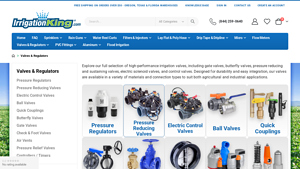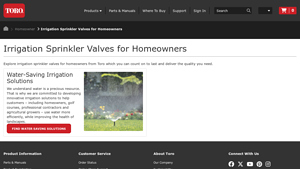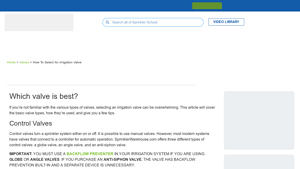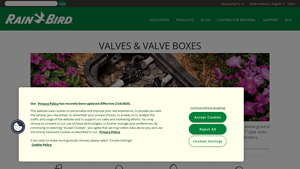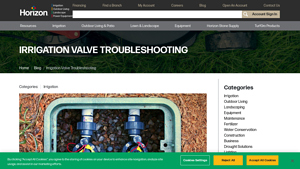Introduction: Navigating the Global Market for irrigation valve
In today’s rapidly evolving agricultural landscape, sourcing reliable irrigation valves is critical for optimizing water management and enhancing crop yield. However, international B2B buyers often face challenges in identifying the right type of valve that meets specific operational needs while navigating diverse supplier markets. This comprehensive guide serves as a vital resource for businesses in Africa, South America, the Middle East, and Europe, including key regions like Vietnam and Saudi Arabia.
We delve into the various types of irrigation valves, their applications, and the factors that influence purchasing decisions. From anti-siphon and inline valves to solenoid and manual options, understanding these components is essential for effective irrigation system design. Additionally, we provide insights into supplier vetting processes, ensuring buyers can confidently select reputable manufacturers and distributors.
Cost considerations and market trends are also thoroughly examined, equipping buyers with the knowledge needed to make informed financial decisions. By addressing these key areas, this guide empowers international B2B buyers to navigate the complexities of the global irrigation valve market, ultimately facilitating efficient sourcing and enhancing agricultural productivity. Whether you’re looking to upgrade existing systems or invest in new solutions, this guide will help you streamline your purchasing process and achieve operational excellence.
Understanding irrigation valve Types and Variations
| Type Name | Key Distinguishing Features | Primary B2B Applications | Brief Pros & Cons for Buyers |
|---|---|---|---|
| Anti-Siphon Valve | Prevents backflow, typically has a built-in pressure regulator | Residential and commercial irrigation systems | Pros: Protects water supply, easy installation. Cons: Limited flow rates compared to others. |
| Inline Valve | Installed directly in the pipe, allowing for flow control | Agricultural and large-scale irrigation | Pros: Efficient use of space, can handle high pressure. Cons: More complex installation. |
| Quick Coupling Valve | Allows for rapid connection and disconnection of hoses | Temporary irrigation setups, landscaping | Pros: Fast setup, versatile for various applications. Cons: May be less durable than fixed valves. |
| Globe Valve | Features a spherical body for flow regulation | Industrial and municipal applications | Pros: Excellent flow control, durable. Cons: Larger footprint, can be more expensive. |
| Angle Valve | Designed for corner installations, changes flow direction | Tight spaces, residential areas | Pros: Space-saving design, effective in limited areas. Cons: Limited application scope. |
What Are the Key Characteristics of Anti-Siphon Valves?
Anti-siphon valves are essential for preventing backflow in irrigation systems, safeguarding water quality. They are typically installed above ground and feature a built-in pressure regulator to maintain consistent water flow. These valves are ideal for residential and commercial applications, particularly where drinking water safety is a concern. B2B buyers should consider installation ease and regulatory compliance when selecting anti-siphon valves, as they are often required in municipal codes.
How Do Inline Valves Function in Agricultural Settings?
Inline valves are integrated directly into the irrigation pipeline, allowing for precise flow control. They are commonly used in agricultural and large-scale irrigation systems due to their ability to handle high pressure and large volumes of water. B2B buyers should evaluate the valve’s pressure rating and compatibility with existing systems, as well as the potential need for additional components like pressure regulators for optimal performance.
What Advantages Do Quick Coupling Valves Offer?
Quick coupling valves facilitate rapid connection and disconnection of hoses, making them ideal for temporary irrigation setups or landscaping projects. Their design allows for flexibility and ease of use in various applications. When considering quick coupling valves, B2B buyers should assess the durability of materials, as these valves may not withstand harsh conditions as effectively as fixed options.
Why Choose Globe Valves for Industrial Applications?
Globe valves are designed for excellent flow regulation and are commonly used in industrial and municipal applications. Their spherical body allows for smooth flow control, making them suitable for complex irrigation systems that require precise management of water distribution. B2B buyers should weigh the benefits of durability and control against the larger footprint and higher costs associated with globe valves.
When Are Angle Valves the Right Choice?
Angle valves are specifically designed to change the direction of flow in irrigation systems, making them ideal for installations in tight spaces. Their compact design allows for efficient use of limited area, particularly in residential settings. B2B buyers should consider the specific layout of their irrigation systems and the potential need for specialized fittings when selecting angle valves, as their application scope is somewhat limited compared to other valve types.
Key Industrial Applications of irrigation valve
| Industry/Sector | Specific Application of irrigation valve | Value/Benefit for the Business | Key Sourcing Considerations for this Application |
|---|---|---|---|
| Agriculture | Drip Irrigation Systems | Improved water efficiency and crop yield | Compatibility with existing systems, durability, and pressure ratings |
| Landscape Management | Automatic Sprinkler Systems | Enhanced aesthetic appeal and reduced labor costs | Flow control features, ease of installation, and material quality |
| Golf Course Maintenance | High-Pressure Sprinkler Systems | Consistent turf quality and reduced water wastage | Heavy-duty construction, resistance to corrosion, and reliability |
| Municipal Water Management | Water Distribution Networks | Efficient resource management and compliance with regulations | Sizing, material options, and pressure handling capabilities |
| Industrial Agriculture | Reclaimed Water Irrigation Systems | Sustainable water use and lower operational costs | Anti-siphon features, compatibility with reclaimed water standards, and maintenance requirements |
How Are Irrigation Valves Utilized in Agriculture?
In the agriculture sector, irrigation valves are integral to drip irrigation systems, allowing precise control over water delivery to crops. This targeted watering approach enhances water efficiency, minimizes runoff, and ultimately boosts crop yield. For international buyers, particularly in regions like Africa and South America, sourcing durable valves that withstand varying water pressures and are compatible with local irrigation designs is critical. The ability to customize the valve system based on crop needs can significantly influence agricultural productivity.
What Role Do Irrigation Valves Play in Landscape Management?
Irrigation valves are essential components of automatic sprinkler systems used in landscape management. They enable the precise control of water flow, ensuring that gardens and lawns receive adequate hydration without waste. This not only enhances the aesthetic appeal of the landscape but also reduces labor costs associated with manual watering. Buyers in Europe and the Middle East should consider valves with adjustable flow rates and ease of installation to streamline their landscape maintenance operations.
Why Are Irrigation Valves Important for Golf Course Maintenance?
In golf course maintenance, high-pressure sprinkler systems rely heavily on irrigation valves to manage water distribution across expansive turf areas. These valves ensure consistent watering, which is crucial for maintaining turf quality and preventing water wastage. For B2B buyers in regions like Saudi Arabia, where water scarcity is a concern, investing in heavy-duty valves that resist corrosion and provide reliable performance under high pressure can lead to significant cost savings and sustainability in operations.
How Do Municipal Water Management Systems Benefit from Irrigation Valves?
Municipal water management systems utilize irrigation valves to regulate water distribution networks effectively. These valves help ensure compliance with environmental regulations and improve resource management by controlling water flow to various sectors, including residential and commercial. Buyers in international markets must focus on sourcing valves that can handle specific pressures and flow rates while being durable enough to withstand harsh environmental conditions.
What Are the Advantages of Using Irrigation Valves in Industrial Agriculture?
In industrial agriculture, irrigation valves are vital for systems utilizing reclaimed water. These valves allow for sustainable water use, significantly reducing operational costs while adhering to environmental standards. For buyers, particularly in developing regions, it is essential to select valves equipped with anti-siphon features to prevent contamination and ensure compliance with health regulations. Understanding the specific requirements for reclaimed water systems can lead to more effective irrigation solutions and enhanced sustainability.
3 Common User Pain Points for ‘irrigation valve’ & Their Solutions
Scenario 1: Inconsistent Water Flow Leading to Crop Damage
The Problem: A common issue faced by agricultural businesses is the inconsistency of water flow due to malfunctioning irrigation valves. These valves may become clogged with debris or fail to open or close properly, leading to overwatering or underwatering of crops. In regions where water scarcity is a significant concern, such inefficiencies can lead to crop damage, reduced yields, and financial losses. The variability in water supply not only affects immediate crop health but can also disrupt long-term farming plans.
The Solution: To mitigate this problem, B2B buyers should invest in high-quality, durable irrigation valves designed for specific agricultural applications. It is crucial to select valves that come equipped with features such as anti-siphon designs to prevent contamination and clog-resistant mechanisms to handle debris. Regular maintenance, including periodic inspections and cleaning, can help ensure that valves function correctly. Additionally, implementing a smart irrigation system with real-time monitoring can provide alerts for any inconsistencies in water flow, allowing for quick corrective action.
Scenario 2: High Replacement Costs Due to Valve Failures
The Problem: Many businesses experience high replacement costs due to frequent failures of low-quality irrigation valves. This is especially prevalent in harsh environmental conditions, such as extreme temperatures or corrosive soils, which can deteriorate standard valves rapidly. In regions like the Middle East, where temperatures can soar, and in South America with varied soil types, the choice of valve material becomes critical. Frequent replacements not only incur costs but also disrupt operations and can lead to project delays.
The Solution: To address this issue, B2B buyers should prioritize sourcing irrigation valves made from materials suitable for their specific environmental conditions. For instance, selecting brass or high-grade plastic valves can enhance longevity in harsh climates. Investing in valves with extended warranties can also provide an additional layer of financial protection. Furthermore, collaborating with reputable suppliers who offer comprehensive product support and guidance on the right materials can help ensure that businesses make informed purchasing decisions that minimize long-term costs.
Scenario 3: Complicated Installation Processes Leading to Downtime
The Problem: Complicated installation processes for irrigation valves can lead to significant downtime, impacting agricultural cycles and project timelines. B2B buyers often find that intricate valve designs require specialized skills or tools for installation, which can be a barrier, especially in remote areas or where skilled labor is scarce. This can result in delays that affect not only current projects but also future planning and resource allocation.
The Solution: To streamline the installation process, B2B buyers should consider purchasing irrigation valves that are designed for easy installation. Look for products with user-friendly features such as pre-assembled components or modular designs that allow for straightforward assembly without specialized tools. Providing training sessions for local technicians on the best practices for installation and maintenance can also empower teams and reduce reliance on external contractors. Additionally, sourcing valves from suppliers who provide comprehensive installation manuals or video tutorials can further enhance the ease of setup and reduce downtime.
Strategic Material Selection Guide for irrigation valve
What are the Key Properties of Common Materials Used for Irrigation Valves?
When selecting materials for irrigation valves, understanding the properties of each material is crucial for ensuring optimal performance in various environmental conditions. Here, we analyze four common materials: plastic, brass, stainless steel, and ductile iron.
How Does Plastic Perform in Irrigation Valve Applications?
Plastic is widely used in irrigation valves, especially for residential and light commercial applications. Key properties include lightweight design, resistance to corrosion, and ease of installation. Plastic valves typically have a temperature rating up to 140°F (60°C) and can handle pressures around 150 psi.
Pros: Plastic valves are cost-effective, lightweight, and resistant to corrosion and chemicals, making them suitable for a variety of irrigation applications.
Cons: They may not withstand extreme temperatures or high-pressure environments as effectively as metal valves. Additionally, plastic can become brittle over time when exposed to UV light.
Impact on Application: Plastic valves are compatible with most water types, but users should ensure they are rated for specific chemicals if used in agricultural settings.
Considerations for International Buyers: Compliance with local standards such as ASTM or ISO is essential, particularly in regions with strict environmental regulations. Buyers should also consider UV resistance if the valves will be exposed to sunlight.
What Advantages Does Brass Offer for Irrigation Valves?
Brass is another popular material for irrigation valves, particularly in commercial and industrial applications. It boasts high durability, with a temperature rating of up to 200°F (93°C) and pressure ratings often exceeding 300 psi.
Pros: Brass valves are robust, resistant to corrosion, and have excellent sealing capabilities, making them ideal for high-pressure systems.
Cons: The higher cost of brass compared to plastic can be a drawback for budget-conscious projects. Additionally, brass can corrode in certain water conditions, especially if not properly maintained.
Impact on Application: Brass is highly suitable for potable water applications due to its non-toxic properties. However, it may not be ideal for highly acidic or alkaline environments.
Considerations for International Buyers: Brass valves must comply with health and safety regulations, particularly in regions like Europe where drinking water standards are stringent. Buyers should also be aware of the potential for lead content in brass and seek lead-free options.
Why Choose Stainless Steel for Irrigation Valves?
Stainless steel is favored for its exceptional strength and corrosion resistance, making it ideal for harsh environments. It can handle temperatures up to 400°F (204°C) and pressures exceeding 500 psi.
Pros: Stainless steel valves are highly durable and resistant to a wide range of chemicals, making them suitable for industrial applications.
Cons: The primary disadvantage is cost, as stainless steel valves are significantly more expensive than both plastic and brass options. They also require more complex manufacturing processes.
Impact on Application: Stainless steel is compatible with various media, including corrosive chemicals, making it a versatile choice for specialized applications.
Considerations for International Buyers: Buyers should ensure compliance with international standards such as DIN or JIS, especially in regions with rigorous industrial regulations. The higher cost may also necessitate a detailed cost-benefit analysis.
What Role Does Ductile Iron Play in Irrigation Valve Selection?
Ductile iron is often used for heavy-duty applications, such as municipal irrigation systems. It has a high tensile strength and can withstand extreme pressures and temperatures.
Pros: Ductile iron valves are incredibly durable and can handle high flow rates, making them suitable for large-scale irrigation projects.
Cons: The weight of ductile iron can make installation more labor-intensive, and it is more susceptible to corrosion if not properly coated.
Impact on Application: Ductile iron is suitable for high-pressure systems and can be used in various water types, though protective coatings are often necessary to prevent corrosion.
Considerations for International Buyers: Compliance with local standards is critical, particularly in regions where infrastructure durability is paramount. Buyers should also consider the logistics of transporting heavier materials.
Summary Table of Material Selection for Irrigation Valves
| Material | Typical Use Case for irrigation valve | Key Advantage | Key Disadvantage/Limitation | Relative Cost (Low/Med/High) |
|---|---|---|---|---|
| Plastic | Residential and light commercial | Cost-effective and corrosion-resistant | Limited pressure and temperature ratings | Low |
| Brass | Commercial and industrial applications | Robust and excellent sealing | Higher cost and potential corrosion | Medium |
| Stainless Steel | Industrial applications | Exceptional strength and durability | High cost and complex manufacturing | High |
| Ductile Iron | Heavy-duty municipal systems | Very durable and high flow capacity | Heavy and susceptible to corrosion | Medium |
This analysis provides a comprehensive overview of material options for irrigation valves, helping international B2B buyers make informed decisions based on their specific needs and regional standards.
In-depth Look: Manufacturing Processes and Quality Assurance for irrigation valve
What Are the Main Stages in the Manufacturing Process of Irrigation Valves?
The manufacturing process of irrigation valves is a complex and multi-stage operation that ensures high-quality products suitable for various applications, from residential gardens to large agricultural projects. Below are the primary stages involved in the manufacturing process:
Material Preparation
The first step involves selecting and preparing the raw materials, which are typically plastic, brass, or other metals, depending on the intended application of the valve. For residential and light commercial applications, high-density polyethylene (HDPE) or PVC is common due to its resistance to corrosion and lightweight nature. In contrast, for heavy-duty applications like municipal systems or golf courses, brass and stainless steel are preferred due to their durability and ability to withstand higher pressures.
Once the materials are sourced, they undergo a quality check to ensure they meet the required specifications. This includes verifying the chemical composition and physical properties of the materials, often through laboratory testing.
Forming Techniques
After material preparation, the forming stage begins. This typically involves methods such as injection molding for plastic valves or machining for metal valves.
Injection Molding: In this process, heated plastic is injected into molds to create the valve body and other components. This method is highly efficient for mass production, providing uniformity in size and shape.
Machining: For metal valves, machining techniques such as CNC (Computer Numerical Control) machining are used to achieve precise dimensions. This allows for the creation of intricate designs and ensures a tight fit for all components.
These forming techniques are critical for achieving the necessary specifications and tolerances that ensure the valves function correctly under varying pressure and flow conditions.
Assembly Process
Once the individual components are formed, they are assembled into the final product. This stage often involves the following steps:
Component Integration: The valve body, diaphragm, solenoid, and other parts are brought together. This might include manual assembly or automated processes, depending on the volume and complexity of the valves being produced.
Sealing and Fastening: Components are sealed to prevent leaks, often using O-rings or gaskets. Fasteners such as screws or bolts are used to secure parts together, ensuring that the valve operates under pressure without failure.
Quality Checks: During assembly, quality checks are performed to ensure that all components fit correctly and that there are no visible defects.
Finishing Touches
The final stage of the manufacturing process is finishing. This includes surface treatments to enhance durability and aesthetics, such as:
Coating: Applying protective coatings to prevent corrosion, especially for metal valves. This can include galvanization or powder coating.
Labeling and Packaging: Proper labeling is essential for identification and compliance with international standards. Valves are then packaged securely for shipping to prevent damage during transit.
What Quality Assurance Standards Should B2B Buyers Consider?
Quality assurance is a critical aspect of the irrigation valve manufacturing process, particularly for international buyers who require compliance with specific standards. Here are the key points regarding quality assurance:
International Standards Compliance
ISO 9001: This is a widely recognized international standard for quality management systems (QMS). It ensures that the manufacturing process meets customer and regulatory requirements consistently. Manufacturers should have certifications that demonstrate compliance with ISO 9001.
CE Marking: For products sold in the European Union, CE marking indicates that the product meets EU safety, health, and environmental protection standards. This is crucial for B2B buyers in Europe.
API Standards: For irrigation valves used in oil and gas applications, adherence to American Petroleum Institute (API) standards may be necessary. This ensures that the valves can withstand extreme conditions often encountered in these industries.
Quality Control Checkpoints
Quality control (QC) is integrated at various checkpoints throughout the manufacturing process:
Incoming Quality Control (IQC): This involves inspecting raw materials upon arrival at the manufacturing facility to ensure they meet specified requirements.
In-Process Quality Control (IPQC): QC measures are taken during the manufacturing process to monitor and control quality. This can include dimensional checks and functional tests on components.
Final Quality Control (FQC): Before the valves are packaged, a final inspection is performed to ensure that each unit meets quality standards and specifications.
Common Testing Methods for Irrigation Valves
B2B buyers should be aware of the various testing methods used to ensure the quality and reliability of irrigation valves:
Pressure Testing: Valves are subjected to high-pressure tests to ensure they can handle the maximum operating pressure without leaking.
Flow Testing: This test measures the flow rate through the valve to ensure it meets the specified performance criteria.
Durability Testing: Valves are tested under extreme conditions to assess their longevity and performance over time.
How Can B2B Buyers Verify Supplier Quality Control Practices?
For international buyers, verifying a supplier’s quality control practices is essential to ensure product reliability and compliance. Here are some actionable steps:
Supplier Audits: Conduct regular audits of the manufacturing facilities to evaluate their quality control processes, certifications, and overall production capabilities.
Request Quality Reports: Suppliers should provide quality assurance reports, including results from various testing methods, compliance certificates, and any relevant documentation regarding quality control measures.
Third-Party Inspections: Engaging third-party inspection services can provide an unbiased assessment of the supplier’s quality practices. This is particularly useful for buyers in regions where local standards may vary.
What Are the Quality Control Nuances for International Buyers?
International buyers, particularly those from Africa, South America, the Middle East, and Europe, should consider the following nuances in quality control:
Regulatory Compliance: Different regions may have varying regulations regarding irrigation products. Understanding these local regulations can prevent compliance issues.
Cultural Differences: Expectations regarding quality and service can differ significantly. Establishing clear communication and understanding the cultural context can facilitate better supplier relationships.
Logistics and Shipping Considerations: Quality control doesn’t end at the factory. Ensuring that products are transported securely and handled properly during shipping is crucial to maintaining quality.
By following these guidelines, B2B buyers can make informed decisions when selecting suppliers for irrigation valves, ensuring they receive high-quality products that meet international standards.
Practical Sourcing Guide: A Step-by-Step Checklist for ‘irrigation valve’
In the competitive landscape of irrigation systems, sourcing the right irrigation valves is crucial for ensuring efficiency and longevity. This guide serves as a practical checklist for B2B buyers aiming to procure irrigation valves tailored to their specific needs, particularly in diverse markets such as Africa, South America, the Middle East, and Europe.
Step 1: Define Your Technical Specifications
Establishing clear technical specifications is the foundation of your sourcing process. Consider factors like valve type (e.g., anti-siphon, inline), size, pressure ratings, and material (plastic vs. metal). Tailoring your specifications to your irrigation system’s requirements will facilitate compatibility and optimize performance.
Step 2: Research and Identify Reliable Suppliers
Conduct thorough research to identify suppliers with a proven track record in the irrigation sector. Utilize industry directories, trade shows, and online reviews to compile a list of potential vendors. Look for suppliers who specialize in your specific valve requirements and have experience in your target region.
Step 3: Evaluate Supplier Certifications and Compliance
Ensure that potential suppliers adhere to international standards and certifications relevant to irrigation products. This may include ISO certifications or compliance with local regulations. Verification of these credentials is vital to guarantee product quality and to minimize the risk of costly failures.
Step 4: Request Detailed Product Information
Engage suppliers by requesting comprehensive product catalogs and specifications. This should include technical data sheets, warranty information, and installation guidelines. Detailed product information helps in assessing whether the valves meet your defined specifications and quality expectations.
Step 5: Inquire About Pricing and Payment Terms
Obtain quotes from multiple suppliers to compare pricing and payment terms. When evaluating costs, consider not only the initial purchase price but also factors such as shipping, taxes, and potential tariffs. Understanding the total cost of ownership will help you make a more informed decision.
Step 6: Assess Lead Times and Delivery Options
Establish clear timelines for delivery and assess the suppliers’ ability to meet your project deadlines. Inquire about their logistics capabilities, including shipping methods and options for expedited delivery if necessary. Timely delivery is crucial to prevent project delays.
Step 7: Seek References and Testimonials
Before finalizing your supplier choice, request references from previous clients, especially those in similar industries or regions. Testimonials can provide insights into the supplier’s reliability, product performance, and after-sales support. Engaging with past clients will also help you gauge the supplier’s commitment to customer satisfaction.
By following this checklist, B2B buyers can streamline the sourcing process for irrigation valves, ensuring that they select the most suitable products and suppliers for their specific needs. This strategic approach not only enhances operational efficiency but also fosters long-term partnerships within the irrigation industry.
Comprehensive Cost and Pricing Analysis for irrigation valve Sourcing
What Are the Key Cost Components in Irrigation Valve Sourcing?
When sourcing irrigation valves, understanding the cost structure is essential for making informed purchasing decisions. The primary cost components include materials, labor, manufacturing overhead, tooling, quality control (QC), logistics, and supplier margin.
Materials: The type of materials used (e.g., plastic, brass, or PVC) significantly impacts the cost. Brass valves tend to be more expensive due to their durability and resistance to corrosion, while plastic valves are generally more cost-effective for residential applications.
Labor: Labor costs vary by region and production method. Automated manufacturing processes may reduce labor costs, but they require upfront investment in machinery. In contrast, manual assembly can increase labor costs but may offer flexibility for customized products.
Manufacturing Overhead: This encompasses all indirect costs associated with production, such as utilities, depreciation of machinery, and facility maintenance. Efficient production processes can help minimize these costs.
Tooling: Custom tooling for specialized valve designs can be a significant upfront investment. However, when producing large volumes, these costs can be amortized over many units, lowering the per-unit cost.
Quality Control (QC): Investing in QC ensures that the valves meet specific standards and certifications, which can be crucial for certain markets. Rigorous QC processes can add to initial costs but can save money in the long run by reducing returns and warranty claims.
Logistics: Shipping and handling costs can vary widely based on the location of the supplier and the buyer. International buyers should consider factors like freight charges, import duties, and potential delays at customs.
Margin: Suppliers typically add a margin to cover their costs and profit. This margin can vary based on competition, brand reputation, and the perceived value of the product.
How Do Price Influencers Impact Irrigation Valve Costs?
Several factors influence the pricing of irrigation valves in the B2B market:
Volume/MOQ: Minimum order quantities (MOQ) can affect pricing. Purchasing in bulk typically leads to lower per-unit costs. Suppliers often provide discounts for larger orders, making it beneficial for buyers to consolidate their purchases.
Specifications and Customization: Custom designs or specific features (e.g., anti-siphon capabilities, flow control) can increase costs. Buyers should clearly define their requirements to avoid unexpected expenses.
Materials: The choice of materials not only affects the initial price but also the longevity and maintenance costs of the valves. Higher-quality materials may lead to a higher upfront cost but can result in lower Total Cost of Ownership (TCO) over time.
Quality and Certifications: Certifications such as ISO or specific agricultural standards can influence pricing. Valves that meet higher standards often come at a premium, but they may offer better reliability and efficiency.
Supplier Factors: The supplier’s reputation, reliability, and service level can impact pricing. Established suppliers may charge more but offer superior quality and support, which can justify the higher cost.
Incoterms: Understanding the terms of shipping (e.g., FOB, CIF) is crucial for international buyers. Incoterms define who is responsible for shipping costs and risks, affecting the overall price.
What Are the Best Buyer Tips for Cost-Efficient Irrigation Valve Sourcing?
To optimize costs when sourcing irrigation valves, buyers should consider the following tips:
Negotiate Prices: Engage in negotiations with suppliers, especially for larger orders. Many suppliers expect some level of negotiation and may offer discounts for bulk purchases.
Focus on Total Cost of Ownership: Evaluate not just the purchase price but also the long-term costs associated with maintenance, repairs, and energy efficiency. A slightly higher initial investment can lead to significant savings over time.
Research Multiple Suppliers: Obtain quotes from various suppliers to compare prices and terms. This competitive approach can lead to better deals and more favorable contract terms.
Consider Local Suppliers: For international buyers, sourcing from local suppliers can reduce shipping costs and delivery times. Additionally, local suppliers may have a better understanding of regional regulations and standards.
Be Aware of Pricing Nuances: International buyers should be mindful of currency fluctuations, tariffs, and trade agreements that can impact pricing. Understanding these factors can aid in making more accurate cost projections.
In summary, a comprehensive understanding of the cost structure, pricing influencers, and strategic purchasing practices can significantly enhance the sourcing experience for irrigation valves, particularly for international buyers in diverse markets.
Alternatives Analysis: Comparing irrigation valve With Other Solutions
Exploring Alternatives to Irrigation Valves for Efficient Water Management
In the realm of agricultural and landscape irrigation, choosing the right water management solution is crucial for maximizing efficiency and minimizing costs. While irrigation valves are widely recognized for their role in controlling water flow, several alternative solutions can also achieve similar objectives. This section compares irrigation valves with two viable alternatives: drip irrigation systems and smart irrigation controllers.
| Comparison Aspect | Irrigation Valve | Drip Irrigation System | Smart Irrigation Controller |
|---|---|---|---|
| Performance | Highly effective for managing water flow | Provides targeted watering, reducing waste | Optimizes watering schedules based on weather data |
| Cost | Moderate initial investment; varies by type | Higher upfront costs due to installation | Lower initial cost; may require ongoing subscription fees |
| Ease of Implementation | Relatively simple installation | Requires planning and layout design | Easy to install; may need technical know-how for setup |
| Maintenance | Low maintenance; periodic checks needed | Requires regular checks and potential replacements | Minimal maintenance; software updates may be needed |
| Best Use Case | Large-scale agriculture and landscaping | Gardens and crops needing precise water delivery | Areas with fluctuating weather patterns or varying plant needs |
What Are the Advantages and Disadvantages of Drip Irrigation Systems?
Drip irrigation systems are designed to deliver water directly to the plant roots through a network of tubing and emitters. This targeted approach minimizes evaporation and runoff, making it highly efficient for water usage. The main advantage of drip systems is their ability to provide consistent moisture levels, which is critical for plant health. However, they often come with a higher initial cost due to installation and design complexity. Regular maintenance is necessary to prevent clogging and ensure optimal performance, making them less suitable for users who prefer low-maintenance solutions.
How Do Smart Irrigation Controllers Enhance Water Management?
Smart irrigation controllers utilize advanced technology to optimize watering schedules based on real-time weather data, soil moisture levels, and plant needs. They can significantly reduce water usage and costs while improving the health of the landscape. These controllers are generally easy to install and can be managed remotely via smartphone applications. However, they may require an initial investment in technology and potential ongoing subscription fees for premium features. While they offer convenience and efficiency, users must be comfortable with technology to fully leverage their benefits.
Choosing the Right Solution for Your Irrigation Needs
When selecting the right irrigation solution, B2B buyers should consider their specific agricultural or landscaping needs, including the scale of their operations, budget constraints, and maintenance preferences. Irrigation valves are a reliable choice for large-scale applications requiring robust water management. In contrast, drip irrigation systems excel in precision watering for gardens and crops, while smart irrigation controllers offer modern solutions that adapt to changing environmental conditions. By evaluating these alternatives against their operational requirements, buyers can make informed decisions that enhance efficiency and sustainability in their irrigation practices.
Essential Technical Properties and Trade Terminology for irrigation valve
What Are the Key Technical Properties of Irrigation Valves?
When selecting irrigation valves, understanding their technical specifications is crucial for ensuring compatibility and performance in various agricultural and landscaping applications. Here are some essential properties to consider:
Material Composition
– Definition: Irrigation valves are typically made from materials such as PVC, brass, or stainless steel. Each material has distinct properties affecting durability, corrosion resistance, and suitability for specific environments.
– B2B Importance: Choosing the right material impacts the valve’s lifespan and maintenance requirements. For instance, brass valves are more durable and can withstand higher pressures, making them suitable for commercial applications, while plastic valves are often sufficient for residential use.Pressure Rating
– Definition: This refers to the maximum pressure the valve can handle, usually measured in PSI (pounds per square inch).
– B2B Importance: Knowing the pressure rating is vital for ensuring the valve can withstand the operational pressures of the irrigation system. Selecting a valve with an inadequate pressure rating can lead to failures and costly repairs.Flow Rate
– Definition: The flow rate indicates the volume of water that can pass through the valve within a specified time, typically measured in gallons per minute (GPM).
– B2B Importance: Understanding the required flow rate helps in selecting valves that can efficiently manage the water supply, ensuring optimal irrigation without waste or water hammer issues.Connection Type
– Definition: Connection types can include threaded, slip, or flanged connections, determining how the valve integrates with the existing irrigation system.
– B2B Importance: Proper connection types are essential for ensuring leak-free installations and compatibility with other system components, reducing the risk of installation errors.Operating Mechanism
– Definition: Valves can be manually operated or automated using solenoids and controllers.
– B2B Importance: Automated valves enhance efficiency and ease of use, especially in large-scale operations, allowing for scheduled irrigation without manual intervention.Temperature Range
– Definition: This indicates the range of temperatures the valve can operate within safely.
– B2B Importance: Selecting valves that can withstand local temperature extremes prevents failure due to thermal expansion or contraction, particularly in regions with significant temperature fluctuations.
What Are the Common Trade Terms Related to Irrigation Valves?
Understanding industry terminology can streamline communication and negotiations in the B2B landscape. Here are several key terms:
OEM (Original Equipment Manufacturer)
– Definition: A company that produces parts or equipment that may be marketed by another manufacturer.
– Importance: OEM components often ensure compatibility and quality, crucial for maintaining the integrity of irrigation systems.MOQ (Minimum Order Quantity)
– Definition: The smallest quantity of a product that a supplier is willing to sell.
– Importance: Knowing the MOQ helps buyers plan their purchases according to their operational needs and budget constraints.RFQ (Request for Quotation)
– Definition: A document sent to suppliers asking for a price quote on specific products or services.
– Importance: RFQs facilitate comparison shopping and negotiation, allowing buyers to secure favorable pricing and terms.Incoterms (International Commercial Terms)
– Definition: A series of pre-defined commercial terms published by the International Chamber of Commerce (ICC) relating to international commercial law.
– Importance: Understanding Incoterms clarifies the responsibilities of buyers and sellers in international transactions, reducing misunderstandings related to shipping and delivery.Lead Time
– Definition: The time it takes from placing an order to receiving the product.
– Importance: Knowing lead times is crucial for inventory management and ensuring timely project execution, especially in agriculture where timing can affect crop yield.Warranty Period
– Definition: The duration during which the manufacturer guarantees the product’s performance and quality.
– Importance: A robust warranty period indicates confidence in product quality, providing buyers with assurance and reducing long-term operational costs.
By grasping these technical properties and trade terms, B2B buyers can make informed decisions that align with their operational needs and objectives in the irrigation industry.
Navigating Market Dynamics and Sourcing Trends in the irrigation valve Sector
What are the Current Market Dynamics and Key Trends in the Irrigation Valve Sector?
The irrigation valve market is experiencing significant growth driven by increasing agricultural demands, water scarcity, and advancements in irrigation technology. As global populations rise, particularly in regions like Africa and South America, the need for efficient water management systems becomes critical. This urgency is further compounded by climate change, which affects rainfall patterns and water availability. Consequently, international B2B buyers are seeking innovative solutions that enhance the efficiency of irrigation systems while minimizing water wastage.
Emerging trends in sourcing include the adoption of smart irrigation technologies, which integrate IoT devices to automate and optimize water usage. These technologies allow for real-time monitoring and control, which can lead to substantial cost savings and improved crop yields. Moreover, the rise of digital marketplaces is reshaping the procurement process, enabling buyers to compare products, read reviews, and make informed decisions quickly. This shift towards e-commerce in the irrigation sector is particularly pronounced in regions like the Middle East and Europe, where digital infrastructure is more developed.
Additionally, sustainability is becoming a focal point in procurement strategies. Buyers are increasingly prioritizing suppliers that offer eco-friendly products, such as valves made from recycled materials or those that reduce energy consumption. This trend is not only driven by regulatory pressures but also by a growing awareness of corporate social responsibility among businesses worldwide.
How is Sustainability and Ethical Sourcing Influencing the Irrigation Valve Market?
Sustainability and ethical sourcing are paramount in today’s irrigation valve market. The environmental impact of traditional irrigation practices has led to a significant push towards more sustainable solutions. B2B buyers are now more informed about the ecological footprint of their purchases, prompting a shift towards products that contribute to water conservation and soil health.
Ethical supply chains are gaining importance as businesses recognize the need for transparency in sourcing materials. Buyers are increasingly looking for manufacturers that adhere to ethical labor practices and sustainable production methods. Certifications such as ISO 14001 (Environmental Management) and the Global Organic Textile Standard (GOTS) are becoming critical indicators of a supplier’s commitment to sustainability.
Moreover, the use of ‘green’ materials in irrigation valve production is on the rise. Buyers are now seeking valves made from recyclable plastics or metals that can withstand harsh environmental conditions without contributing to pollution. These materials not only meet regulatory standards but also appeal to environmentally conscious consumers, enhancing brand reputation and customer loyalty.
How Have Irrigation Valves Evolved Over Time?
The evolution of irrigation valves has been marked by significant technological advancements and changing agricultural needs. Initially, irrigation systems relied heavily on manual valves and rudimentary control mechanisms, which often led to inefficiencies and water loss. The introduction of automatic and electric valves revolutionized the sector by allowing for precise control over water distribution, thereby optimizing irrigation practices.
In recent years, innovations such as anti-siphon valves and pressure-regulating devices have further improved system efficiency. These advancements not only enhance the functionality of irrigation systems but also contribute to sustainable water management practices. As the market continues to evolve, the focus on smart technologies and eco-friendly materials is likely to shape the future of irrigation valves, meeting the demands of a more sustainable agricultural landscape.
Frequently Asked Questions (FAQs) for B2B Buyers of irrigation valve
How do I choose the right irrigation valve for my system?
Choosing the right irrigation valve involves understanding your specific needs, including the type of irrigation system, water pressure, and flow rate. For example, anti-siphon valves are essential for preventing backflow, while inline valves are more common for underground systems. Consider the material as well; plastic valves are suitable for residential use, whereas brass valves are better for heavy-duty applications. Consulting with suppliers about your system’s specifications can help ensure you make an informed decision.What is the best type of irrigation valve for commercial applications?
For commercial applications, especially in agricultural or municipal settings, brass or heavy-duty plastic valves are recommended due to their durability and ability to handle high water pressures. Electric solenoid valves are often preferred for automated systems, as they provide precise control over water flow. Additionally, consider valves with adjustable flow control features, allowing for better management of varying irrigation needs across different zones.What are the common materials used in irrigation valves, and how do they affect performance?
Irrigation valves are typically made from plastic or metal. Plastic valves are lightweight and resistant to corrosion, making them ideal for residential and light commercial applications. However, they may not withstand high pressures as well as metal valves. Brass valves offer durability and can handle higher pressures, making them suitable for more demanding environments like golf courses or industrial applications. The choice of material should align with your specific operational conditions and longevity requirements.What minimum order quantities (MOQs) should I expect when sourcing irrigation valves?
Minimum order quantities (MOQs) for irrigation valves can vary significantly based on the supplier and the type of valve. Generally, MOQs can range from as low as 10 to over 500 units, especially for specialized or customized products. It’s advisable to discuss your needs directly with suppliers, as some may offer flexibility for larger or repeat orders. Understanding the MOQ is crucial for budget planning and inventory management.How can I vet suppliers for irrigation valves in international trade?
When vetting suppliers for irrigation valves, consider their industry reputation, certifications (such as ISO), and experience in international trade. Request references from previous clients and check online reviews. It’s also beneficial to visit their manufacturing facility if possible, or use third-party inspection services to assess quality. Ensure the supplier can provide documentation for compliance with international standards, especially if you’re importing to regions with stringent regulations.What payment terms should I negotiate when sourcing irrigation valves?
Payment terms can vary widely among suppliers. Common practices include upfront payments, net 30 or net 60 days, or a letter of credit for larger orders. It’s advisable to negotiate terms that align with your cash flow and minimize financial risk. Consider using escrow services for large transactions to protect both parties. Establishing clear payment terms in the contract will help avoid disputes and ensure smooth transactions.What quality assurance processes should I expect from irrigation valve suppliers?
Quality assurance processes can include material testing, dimensional checks, and pressure testing to ensure valves meet specified standards. Reputable suppliers should have documented QA protocols and be willing to share their quality control certifications. Look for suppliers who can provide samples or conduct third-party testing to verify product integrity. Regular audits of the manufacturing process can also ensure ongoing compliance with quality expectations.How do logistics and shipping impact the sourcing of irrigation valves internationally?
Logistics and shipping play a critical role in international sourcing, affecting lead times and costs. Consider the supplier’s location, shipping methods, and potential tariffs or duties that may apply. It’s essential to coordinate with freight forwarders to ensure timely delivery and manage customs clearance. Additionally, understanding the supplier’s experience with international logistics can help mitigate risks related to delays or damage during transit. Always factor in these logistics considerations when planning your orders.
Important Disclaimer & Terms of Use
⚠️ Important Disclaimer
The information provided in this guide, including content regarding manufacturers, technical specifications, and market analysis, is for informational and educational purposes only. It does not constitute professional procurement advice, financial advice, or legal advice.
While we have made every effort to ensure the accuracy and timeliness of the information, we are not responsible for any errors, omissions, or outdated information. Market conditions, company details, and technical standards are subject to change.
B2B buyers must conduct their own independent and thorough due diligence before making any purchasing decisions. This includes contacting suppliers directly, verifying certifications, requesting samples, and seeking professional consultation. The risk of relying on any information in this guide is borne solely by the reader.
Top 7 Irrigation Valve Manufacturers & Suppliers List
1. Rain Bird – Sprinkler Valves
Domain: store.rainbird.com
Registered: 1995 (30 years)
Introduction: This company, Rain Bird – Sprinkler Valves, is a notable entity in the market. For specific product details, it is recommended to visit their website directly.
2. Sprinkler Supply Store – Sprinkler Valves
Domain: sprinklersupplystore.com
Registered: 2010 (15 years)
Introduction: Sprinkler valves are automatic irrigation valves that can be globe or angle (straight or bent) types. They utilize a diaphragm and an electric solenoid to open and close. Typically, sprinkler valves are made of plastic for residential and most commercial applications, while metal valves are used for heavy-duty sites such as golf courses and municipal pumping stations.
3. Irrigation King – Durable Valves & Accessories
Domain: irrigationking.com
Registered: 2016 (9 years)
Introduction: Irrigation valves available include: Ball Valves, Butterfly Valves, Gate Valves, Check & Foot Valves, Electric Control Valves, Pressure Regulators, Pressure Reducing Valves, Quick Couplings, Air Vents, and Pressure Relief Valves. Products are designed for durability and easy integration for agricultural and industrial applications. Specific products include various models of Senninger Pressure Reg…
4. Toro – Irrigation Sprinkler Valves
Domain: toro.com
Registered: 1994 (31 years)
Introduction: Irrigation Sprinkler Valves for Homeowners from Toro are designed for durability and quality. Toro is committed to developing innovative water-saving irrigation solutions for homeowners, golf courses, professional contractors, and agricultural growers, aiming to use water more efficiently and improve landscape health.
5. Sprinkler Warehouse – Control & Emergency Valves
Domain: school.sprinklerwarehouse.com
Registered: 1999 (26 years)
Introduction: Control Valves: Globe Valve, Angle Valve, Anti-Siphon Valve. Emergency Valves: Gate Valve, Ball Valve. Globe Valves: Installed underground, available in various sizes, cheaper than angle and anti-siphon valves, requires separate backflow preventer. Angle Valves: 90-degree angle design, moderates pressure drop, requires separate backflow preventer. Anti-Siphon Valves: Built-in backflow prevention, …
6. Rain Bird – Efficient Irrigation Valves and Boxes
Domain: rainbird.com
Registered: 1995 (30 years)
Introduction: Rain Bird offers a variety of valves and valve boxes designed for efficient irrigation systems. The valves are built for durability and reliability, featuring options such as anti-siphon and pressure-regulating designs. The valve boxes are made from high-quality materials to protect valves from environmental damage and allow for easy access for maintenance. Key features include easy installation, …
7. Horizon – Checkmate 3, Checker Plus, Checker Jr.
Domain: horizononline.com
Registered: 1997 (28 years)
Introduction: Horizon offers troubleshooting guidance for irrigation valves, including checks for electrical and mechanical issues. Key products mentioned include the Checkmate 3, Checker Plus, and Checker Jr., which are devices for verifying solenoid operation. The troubleshooting process involves checking water supply, controller functionality, solenoid operation, and valve components. If repairs are needed, …
Strategic Sourcing Conclusion and Outlook for irrigation valve
In the dynamic landscape of global irrigation solutions, strategic sourcing of irrigation valves is paramount for ensuring efficiency, reliability, and cost-effectiveness. As we have explored, the selection of high-quality valves from reputable manufacturers not only enhances the performance of irrigation systems but also mitigates risks associated with supply chain disruptions. Key considerations for B2B buyers include understanding the specific needs of their agricultural or landscaping projects, evaluating valve materials and types, and recognizing the importance of compatibility with existing systems.
Furthermore, leveraging local suppliers while maintaining a diverse pool of international options can significantly optimize procurement processes. As markets in Africa, South America, the Middle East, and Europe continue to evolve, the demand for advanced irrigation technology will grow, presenting abundant opportunities for businesses that adopt forward-thinking sourcing strategies.
Looking ahead, we encourage international buyers to stay informed about market trends and innovations in irrigation technology. By investing in strategic sourcing today, you can position your business for success in tomorrow’s competitive landscape. Engage with trusted suppliers and explore sustainable solutions that align with your operational goals. The future of irrigation is bright—seize the opportunity to lead in this essential industry.

